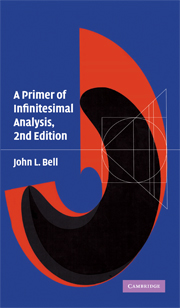Book contents
- Frontmatter
- Contents
- Preface
- Acknowledgements
- Introduction
- 1 Basic features of smooth worlds
- 2 Basic differential calculus
- 3 First applications of the differential calculus
- 4 Applications to physics
- 5 Multivariable calculus and applications
- 6 The definite integral. Higher-order infinitesimals
- 7 Synthetic differential geometry
- 8 Smooth infinitesimal analysis as an axiomatic system
- Appendix. Models for smooth infinitesimal analysis
- Note on sources and further reading
- References
- Index
3 - First applications of the differential calculus
Published online by Cambridge University Press: 29 January 2010
- Frontmatter
- Contents
- Preface
- Acknowledgements
- Introduction
- 1 Basic features of smooth worlds
- 2 Basic differential calculus
- 3 First applications of the differential calculus
- 4 Applications to physics
- 5 Multivariable calculus and applications
- 6 The definite integral. Higher-order infinitesimals
- 7 Synthetic differential geometry
- 8 Smooth infinitesimal analysis as an axiomatic system
- Appendix. Models for smooth infinitesimal analysis
- Note on sources and further reading
- References
- Index
Summary
In this chapter we turn to some of the traditional applications of the calculus, namely, the determination of areas, volumes, arc lengths, and centres of curvature. The arguments here take the form of direct computations, based on the analysis of figures: they can be rigorized quite easily by introducing the definite integral function over a closed interval, which will be deferred until Chapter 6.
In these applications, as well as in the physical applications to be presented in subsequent chapters, the role of infinitesimals will be seen to be twofold. First, as straight microsegments of curves, they play a ‘geometric’ role, enabling each infinitesimal figure to be taken as rectilinear, and as a result, ensuring that its area or volume, as the case may be, is a definite calculable quantity. And second, as nilsquare quantities, they play an ‘algebraic’ role in reducing the results of these calculations to a simple form, from which the desired result can be obtained by the Principle of Microcancellation.
Areas and volumes
We begin by determining the area of a circle. The method here – which was employed by Kepler (see Baron 1969) – is to consider the circle as being composed of a plurality of small isoceles triangles, each with its base on the circumference and apex at the centre (Fig. 3.1). Thus let C(x) be the area of the sector OPQ of the given circle, where Q has abscissa x.
- Type
- Chapter
- Information
- A Primer of Infinitesimal Analysis , pp. 35 - 48Publisher: Cambridge University PressPrint publication year: 2008

